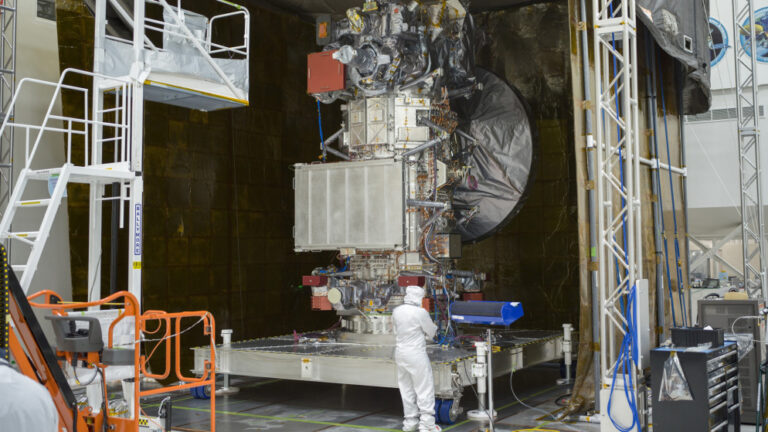Finally, the spacecraft may be tested in its entirety by JPL engineers before its October launch.
In the latter part of this year, NASA intends to launch the Europa Clipper spacecraft in the direction of Jupiter, and preparations for the spacecraft are currently being made. In spite of the fact that reaching Europa and surviving in orbit around Jupiter is not an easy task, there is a possibility that the subsurface ocean of Europa would have the components necessary for life. The fact that all nine of the sensors that were designed for the mission have been placed aboard Europa Clipper is a significant milestone that NASA has announced the project has achieved. For the very first time, this enables the engineers working for NASA to test the entire spaceship with its entirety.
NASA’s Jet Propulsion Laboratory (JPL), located in southern California, is now in the process of preparing the Europa Clipper for its upcoming mission. The transportation of the spacecraft to the Jovian system will begin in October, when it will be put onto a SpaceX Falcon Heavy rocket and set out on its lengthy journey. At first, NASA intended to launch this mission using the Space Launch System; but, because to delays in the construction of those rockets, NASA was left with little alternative but to abandon that plan. In the launch services industry, SpaceX is the only company that possesses a super-heavy lift rocket that is ready to go.
The development of Europa Clipper during this period is of the utmost significance to the accomplishment of the mission. Because of the manner in which it will investigate Jupiter’s moon, the Clipper was given its name. Europa is located far within Jupiter’s powerful radiation field, which means that if the probe were to approach the orbit of the moon and remain there, there is a significant possibility that it would have a catastrophic breakdown. The mission will therefore make use of an approach that is analogous to the one that was successful in preserving the Juno spacecraft. Before it is removed from the danger zone by its eccentric orbit, it will make 44 flybys of Europa, during which it will collect further data with each flyby.
For the purpose of investigating the moon’s atmosphere, the spacecraft is equipped with three instruments: the MASPEX spectrometer will analyze trace gasses, an ultraviolet spectrograph (Europa-UVS) will keep an eye out for plumes of water escaping from the surface, and a different spectrometer (SUDA) will scan dust particles that are flung into space by those geysers. The MISE spectrometer is yet another spectrometer that has been developed for the purpose of searching for organics, salts, water ice, and other components that may have biological importance. For the purpose of mapping the ice sheet and searching for signs of water underneath the surface, a radar device known as REASON will be utilized.
There is no need to be concerned because there is also a visible light camera (EIS) onboard, which will provide pictures of Europa from both a tight and broad angle, revealing an incredible level of detail. As a result, you may anticipate seeing some breathtaking photographs of Europa as well as the fundamental scientific facts. Additional spatial data will be added by a separate infrared imager known as E-THEMIS, which will also look for signs of geological activity.
Because of the Clipper’s approach, it is necessary for all nine instruments to be functioning in harmony. By layering this information, scientists will be able to generate a comprehensive picture of Europa and the water that is most likely hiding beneath its frozen exterior. “The instruments work together hand in hand to answer our most pressing questions about Europa,” said Robert Pappalardo, a scientist at JPL who is working on the Europa Clipper project. “We will learn what makes Europa tick, from its core and rocky interior to its ocean and ice shell to its very thin atmosphere and the surrounding space environment.”

